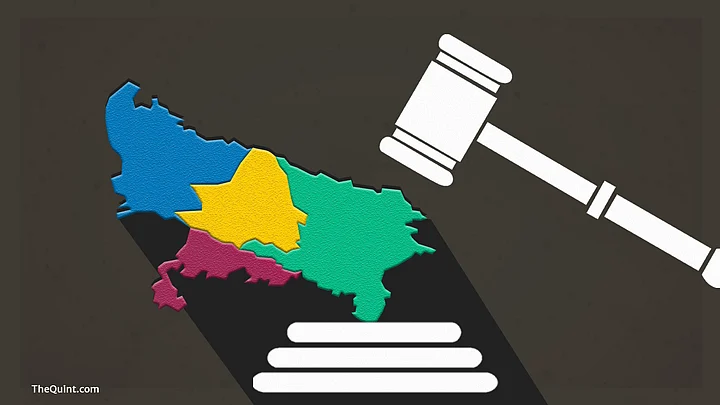The question of the division of Uttar Pradesh into four states was a major poll issue during the build up to the 2012 UP Assembly Elections.
In 2011, then UP Chief Minister and Bahujan Samaj Party (BSP) chief, Mayawati, passed a resolution in the Assembly to split UP into four smaller states – Purvanchal, Bundelkhand, Awadh Pradesh and Paschim Pradesh – in the interest of providing better administration. The resolution later got stuck with the Congress government at the centre.
Becoming Uttar Pradesh
The populist move was an attempt on Mayawati’s part to sway the vote in BSP’s favour. However, the Samajwadi Party – which was against the split – registered a landslide victory that year. And no party has dared to raise the issue since.
The Uttar Pradesh polls are upon us once more. This time around however, the four-state issue appears to be completely forgotten. UP’s voters aren’t talking about it anymore, and neither are the political parties.
Historically, the state comprised provinces that were collectively called ‘The United Provinces of Agra and Oudh’. This was shortened by the Government of India Act 1935 to United Provinces and was later renamed Uttar Pradesh (as the term ‘province’ didn’t fit in with the idea of Republic).
The first division came about in 2001, when the ruling NDA government carved out a separate state of Uttaranchal (renamed Uttarakhand).
The administrative challenge of governing a state as big as Uttar Pradesh cannot be over-stated. With 18 Administrative Divisions, 75 districts, and more than one lakh villages, Uttar Pradesh is the fifth largest state in India by area and the largest state by population.
If it were made into an independent country, it would be fifth most populous country in the world.
Wealth of the State
UP is rich in natural resources. The empires of ancient India that flourished in the region knew this. With fertile land, natural water resources, a rich culture and an authoritative presence in history – UP has everything that an administrative unit needs in order to write its growth story.
But with such huge population and land area, it becomes difficult for the government to concentrate on development.
The argument that smaller states accelerate the pace of development can be debated, but it appears to be largely a political idea.
In its Election Manifesto for the 2014 Lok Sabha, the BJP emphasised on the the recognition of regional aspirations. In the section titled ‘Strengthen the Framework’, the party built a case for greater decentralisation through smaller states.
The BJP never passes up on opportunities to take credit for creating the states of Jharkhand, Uttarakhand and Chhattisgarh during NDA-I. But this time around, the party is silent, as is Mayawati’s BSP.
How the Idea of Splitting UP Came About
Many believe that Mayawati was the first to propose the splitting up of UP into four smaller administrative units. But this is not true. In 1955, Ambedkar proposed the idea of splitting UP into three states – through his book, ‘Thoughts On Linguistic States’.
He suggested the creation of three states, with Meerut as the capital of the Western Region, Allahabad as the capital of the Eastern Region and Kanpur as the capital of the Central region. This is what the BSP had in mind while proposing the split in 2011.
According to Mayawati’s blueprint, Purvanchal would have 22 eastern districts of the state, including Gorakhpur. Lucknow, the capital, would be a part of Awadh Pradesh; Paschim Pradesh or Harit Pradesh would include Meerut and Ghaziabad; and Bundelkhand would have seven districts.
UP’s Growth Falling Behind National Average
As far as UP’s growth is concerned, the state lags behind in terms of economic development. The state’s social development indicators are equally disappointing.
A 2013 study by the Reserve Bank of India revealed that with a total of 29.43 percent of its population in the Below Poverty Line category, Uttar Pradesh placed 20th in the list of States and Union Territories ranked according to poverty. The state ranked well below the All India average of 21.92 percent (based on MRP consumption).
According to the 2011 Census, only 27.3 percent people in UP have access to tap water, while a depressing 35.7 percent have access to toilets – both well below the national average of 43.5 percent, and 46.9 percent respectively.
Regionally, Pashchimanchal looks economically prosperous while Purvanchal and Awadh lag behind. Meanwhile, in Bundelkhand, including the area under Madhya Pradesh, one sees the India of the 1950s.
Generally, there is a perception that smaller states are easier to manage, in comparison to larger states. However, if we compare the Per Capita GDP or GDP growth rates for each of the Indian states, there is hardly any correlation between the growth rate and size of these states. In fact the growth is mostly dependent on government policies and other factors.
Other issues which go against the division of state are the cost of infrastructure – which will increase with the creation of new states – and reduced self-sustainability –which will adversely affect the Bundelkhand region because of a lack of resources. Not to mention, the split hurts the very idea of ‘unity in diversity.’
The previous decisions regarding the creation of new states have been taken under political pressure. Regionalism, sectarianism and casteism are major deterrents to a united India and the idea of dividing a state based on these factors is certainly not welcome.
(The author is an IT professional and an independent blogger who writes about socio-political issues. He can be reached @YatharthMishra_ . This is a personal blog and the views expressed above are the author’s own. The Quint neither endorses nor is responsible for the same.)
(At The Quint, we question everything. Play an active role in shaping our journalism by becoming a member today.)
